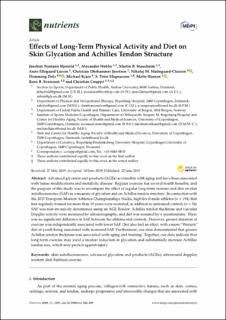| dc.contributor.author | Hjerrild, Joachim Nymann | |
| dc.contributor.author | Wobbe, Alexander | |
| dc.contributor.author | Stausholm, Martin Bjørn | |
| dc.contributor.author | Larsen, Anne Ellegaard | |
| dc.contributor.author | Josefsen, Christian Ohrhammer | |
| dc.contributor.author | Malmgaard-Clausen, Nikolaj M | |
| dc.contributor.author | Dela, Flemming | |
| dc.contributor.author | Kjaer, Michael | |
| dc.contributor.author | Magnusson, S. Peter | |
| dc.contributor.author | Hansen, Mette | |
| dc.contributor.author | Svensson, Rene B | |
| dc.contributor.author | Couppe, Christian | |
| dc.date.accessioned | 2021-04-20T10:37:19Z | |
| dc.date.available | 2021-04-20T10:37:19Z | |
| dc.date.created | 2020-03-24T15:19:11Z | |
| dc.date.issued | 2019 | |
| dc.Published | Nutrients. 2019, 11 (6), 1-16. | |
| dc.identifier.issn | 2072-6643 | |
| dc.identifier.uri | https://hdl.handle.net/11250/2738612 | |
| dc.description.abstract | Advanced glycation end-products (AGEs) accumulate with aging and have been associated with tissue modifications and metabolic disease. Regular exercise has several health benefits, and the purpose of this study was to investigate the effect of regular long-term exercise and diet on skin autofluorescence (SAF) as a measure of glycation and on Achilles tendon structure. In connection with the 2017 European Masters Athletics Championships Stadia, high-level male athletes (n = 194) that had regularly trained for more than 10 years were recruited, in addition to untrained controls (n = 34). SAF was non-invasively determined using an AGE Reader. Achilles tendon thickness and vascular Doppler activity were measured by ultrasonography, and diet was assessed by a questionnaire. There was no significant difference in SAF between the athletes and controls. However, greater duration of exercise was independently associated with lower SAF. Diet also had an effect, with a more “Western” diet in youth being associated with increased SAF. Furthermore, our data demonstrated that greater Achilles tendon thickness was associated with aging and training. Together, our data indicate that long-term exercise may yield a modest reduction in glycation and substantially increase Achilles tendon size, which may protect against injury. | en_US |
| dc.language.iso | eng | en_US |
| dc.publisher | MDPI | en_US |
| dc.rights | Navngivelse 4.0 Internasjonal | * |
| dc.rights.uri | http://creativecommons.org/licenses/by/4.0/deed.no | * |
| dc.title | Effects of Long-Term Physical Activity and Diet on Skin Glycation and Achilles Tendon Structure | en_US |
| dc.type | Journal article | en_US |
| dc.type | Peer reviewed | en_US |
| dc.description.version | publishedVersion | en_US |
| dc.rights.holder | Copyright 2019 The Authors | en_US |
| dc.source.articlenumber | 1409 | en_US |
| cristin.ispublished | true | |
| cristin.fulltext | original | |
| cristin.qualitycode | 1 | |
| dc.identifier.doi | 10.3390/nu11061409 | |
| dc.identifier.cristin | 1803308 | |
| dc.source.journal | Nutrients | en_US |
| dc.source.40 | 11 | |
| dc.source.14 | 6 | |
| dc.identifier.citation | Nutrients. 2019, 11 (6), 1409 | en_US |
| dc.source.volume | 11 | en_US |
| dc.source.issue | 6 | en_US |

